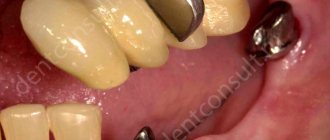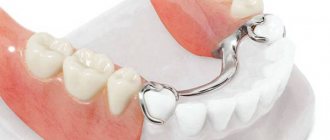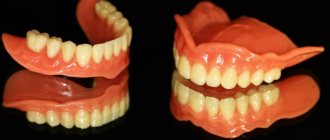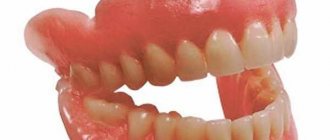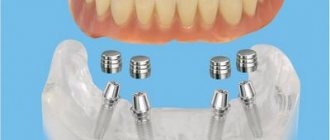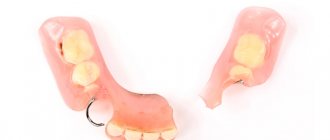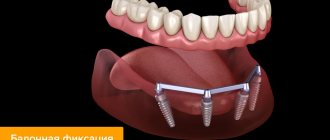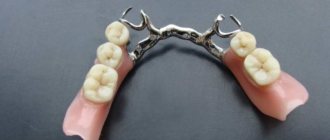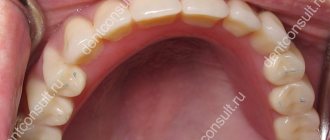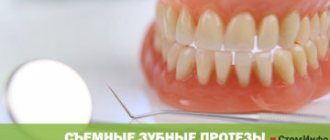Casting technology used in dental laboratories makes it possible to produce durable, high-quality products for restoring elements of the jaw row.
In dental clinics, solid crowns are more often used to restore the anatomical shape of decaying teeth or to create support for a bridge structure.
Design
For the manufacture of solid-cast bridge structures, alloys of various metals and other materials are used. They are a single whole, which does not have soldered elements and the connection of different materials. The manufacturing precision exceeds similar designs of soldered prostheses. In addition, solid cast products are more durable and resistant to mechanical stress, and their fixation is more reliable.
In most cases, stainless steel or gold is used for the manufacture of solid cast structures, both in pure form and with sputtering. To give the product a more attractive appearance, the frame can be covered with a layer of ceramics or porcelain.
The bridge structure is cast as a whole, which is what distinguishes the prosthesis from the composite version. The absence of solder allows for minimal oxidation of the material. This circumstance has a beneficial effect on the condition of the oral mucosa. Soft tissue diseases occur much less frequently.
Kinds
Bridge structures are classified into several types:
- Without coating - they look like polished metal teeth.
- With sputtering - imitate gold.
- With lining on the front side - they have a polymer lining.
- Combined type - combines the characteristics of the above types.
Making a prosthesis is a rather complex procedure that can only be performed by a qualified specialist.
Materials
High-strength metal alloys are used for manufacturing. The most commonly used compounds are chromium and cobalt or nickel. In addition to these metals, titanium can be used, products from which have the following advantages:
- do not cause an allergic reaction;
- do not change color during operation;
- do not cause changes in the acid-base balance of saliva.
Products can be coated with precious metals. Often in this case, titanium nitride is used, thanks to which the structure acquires a golden color. Strength and wear resistance increases, as does the price.
Watch the video about the material used to make solid crowns.
Advantages
Solid-cast bridge prostheses have long gained popularity among dentists and patients due to their advantages:
- Restoring the teeth to their original functions.
- Tight and reliable fixation, which minimizes the possibility of food debris and microorganisms getting under the crown.
- Slow wear of the structure, which allows it to be used for up to 10 years.
- High strength, due to the absence of solder and soldered elements.
- Modeling of both the intermediate part and the supporting teeth in the manufacture of a bridge. As a result, the functionality of the prosthesis increases significantly.
- Performing grinding of the abutment tooth with minimal impact on the soft tissues and the tooth itself.
- Affordable price.
Ease of manufacture and affordable cost for most patients make the one-piece design very popular.
General overview
A one-piece crown is a metal product designed to replace one or more elements of the dentition.
To manufacture such a design, the one-piece casting method is used, which involves a one-stage casting of the product.
At the same time, thanks to this technique, it is possible to manufacture both a single crown and a bridge, the elements of which do not have to be soldered together. The manufacturing method increases the strength of the structure and the duration of its operation.
Flaws
Despite the obvious advantages, fixed one-piece dentures are not without certain disadvantages:
- Unaesthetic. The design is recommended for use in areas of the oral cavity that are not visible when smiling.
- High thermal conductivity, causing inconvenience when eating hot food.
- The need to prepare abutment teeth.
- Installation errors. If during the installation of a solid-cast bridge some errors occurred that were not noticed by the dentist, over time the patient may develop periodontal disease.
- Loosening and damage to supporting teeth due to high load on the bridge.
- Difficulties with hygienic care.
- Higher cost compared to removable dentures.
Nevertheless, the prosthesis is very popular and is often chosen by patients as the main structure.
Find out what a clasp prosthesis is, what its advantages and disadvantages are.
Service life
The average service life of plastic bridges is 2-3 years, i.e. During this period, these structures fully retain all their original indicators.
It is possible to extend the operating time up to 5 years if you properly care for them and follow all operating rules . On the contrary, the lack of proper care, ignoring or insufficiently strictly following the recommendations of a specialist, deteriorates the quality of the structure, and accordingly reduces the service life.
In addition to observing the rules of hygiene and wearing, other factors also directly influence the life of the bridge, namely:
- quality and number of supporting teeth holding this structure;
- prosthesis length;
- condition of periodontal tissues;
- uniform distribution of chewing load.
Important! If the denture is the only way to chew food, its service life will naturally be significantly reduced.
Contraindications
There are many more contraindications for installing bridges:
- The absence of four front teeth is invigorating.
- Blood clotting disorders.
- Presence of cancer or mental disorders.
In some cases, the installation of a bridge is not prohibited, but is not recommended by dentists:
- Bite defects.
- Bruxism (involuntary grinding of teeth).
- Increased tooth wear.
- Periodontal diseases.
- Inflammation of the oral cavity.
- Failure to comply with hygiene rules.
Installation of solid cast structures is allowed after contraindications have been eliminated.
Stages of manufacturing solid-cast bridges
The production and installation of solid dentures is carried out in several stages. The dentist must have sufficient qualifications and strictly follow the sequence of actions when installing the bridge:
- An initial examination of the patient is performed to identify hidden damage and defects. If any diseases are detected, the doctor performs treatment.
- The condition of the periodontium is assessed. If pathologies are detected, oral tissue treatment is performed.
- Preparation of supporting teeth is a mandatory procedure for prosthetics. The operation is performed using anesthesia, as it is quite painful. The supporting teeth are ground on both sides. This processing is due to the fact that the thickness of the crown walls varies from 1.5 to 1.7 millimeters, so installation of a bridge is possible only after turning. In addition, the supporting teeth must have a certain shape to ensure reliable fixation of the bridge.
- After grinding the teeth, impressions of the jaws are taken. The casts are sent to the laboratory, and plaster models are cast from them. In the future, the model will serve as the basis for the manufacture of a solid-cast bridge prosthesis.
- The color of the structure is selected in accordance with the shade of the natural teeth. A special scale is used for this.
- Making a temporary plastic bridge. This prosthesis is installed on the patient and used until the main product is ready. The prosthesis is fixed using a special solution.
- Trying on a permanent product. If the prosthesis completely suits the patient, it is coated with the necessary composition, for example, ceramics. Otherwise, the frame is sent for revision.
- After successful fitting and manufacturing, the structure is mounted to the patient. First, the doctor once again assesses the tightness of the bridge to the teeth, and the patient evaluates the convenience of the structure. Only after this is the final fixation of the product performed.
Installation of a fixed type prosthesis is a complex procedure, after which the patient receives an imitation of natural teeth.
Installation
In order for a complete removable denture, as well as a partial denture, to be optimally suitable for the patient, it is necessary:
- clean the casting from the residual part of the molding compounds;
- saw off the sprues;
- start fitting the casting for each specific model;
- After determining the desired color, the product is returned to the laboratory to complete the work.
Note! It is in the laboratory that the structure is polished and coated with a special varnish (camouflage).
The wax is then replaced with plastic, processed, and the partial or full denture is tested in the mouth. Next, re-polishing and grinding is carried out, after which the product is 100% ready for use. The same is true for stamped soldered bridges.
Teeth after installation of a bridge
Features of care
To extend the life of the product, it is necessary to treat it with special care. First of all, you need to monitor your oral hygiene. It is necessary to clean not only the teeth and bridge, but also the spaces between the denture and gums. In this case, a dry brush is used first, and then a wet one with paste applied to it.
There may be pieces of food between the denture and the gum that cannot be removed with a brush. Trying to remove them with a sharp object is prohibited. Dental floss is suitable for this. Instead of thread, you can use special devices sold in pharmacies. After each meal, it is recommended to rinse your mouth with water or a special solution.
It is worth visiting the dentist regularly. The doctor can notice defects in the product and quickly eliminate them.
If these recommendations are followed, solid-cast bridges can be successfully operated for 10 years or more.
Price
The cost of such prosthetics depends on many factors. These include the level of the clinic, its availability of modern equipment and instruments, and the qualifications of the attending physicians. The complexity of prosthetics also plays a determining role in the final cost, however, the installation of solid bridges is affordable for most patients.
You can install a prosthesis on one crown for an amount starting from $500. Accordingly, the more crowns the prosthesis has, the higher the cost of the product.
Reviews of solid bridges
Petr Alekseevich, Khabarovsk. I installed a bridge more than two years ago. When choosing between an implant and a bridge, I chose the cheaper option. The doctor first installed a temporary prosthesis, which was replaced with a permanent one two weeks later. There were only inconveniences for the first week, after which I got used to it and stopped noticing the structure.
Valery, Moscow. I had to go to the dentist to replace three missing teeth. The doctor gave me a solid bridge. Moreover, first he sharpened the supporting teeth, and a week later he put on permanent crowns. In principle, my appearance suits me. The only annoying thing is that sometimes food remains between the denture and the gums. It takes a long time to brush your teeth. I don't see any other disadvantages of the design.
Nursultan, Astana. I had a rotten tooth removed three years ago. For a long time I didn’t want to build a bridge, but my family convinced me otherwise. At the clinic, they ground my supporting teeth and installed a one-piece denture. The structure has been holding up reliably for a year now. At the same time, I calmly eat and talk without thinking about the prosthesis. Let's see what will happen next.
Oleg, Krasnodar. I originally had gold teeth for several years. But nothing lasts forever. An unpleasant odor began to appear from my mouth. The doctor said that the tooth under the crown had rotted and needed to be removed. We decided to put a bridge in its place. A year and a half has passed, during which time the design has not bothered me. Frequent cleaning, in my opinion, is justified by the appearance and convenience of the product.
Ekaterina Anatolyevna, Simferopol. When I had my front teeth replaced with bridgework, it was important to me to have an attractive smile. Despite the anesthesia, the installation was painful. Nevertheless, I was pleased with the result in terms of aesthetics and adaptation time. I have now been using the bridge for three years and have no plans to change it.
| Cavities are no longer a problem! Do you have caries, but are you afraid to go to the dentist? You can cure it at home! Read more >>> |
| How I whitened my teeth in a short time After 1 week, my teeth became SNOW-WHITE! I just did... Find out more >>> |
| The best remedy for getting rid of headaches Vladimir Pozner: “Because of terrible headaches, my career on TV hung by a thread” Read more >>> |
Your mark:
(votes: 1 , average: 10.00 out of 10)
All the pros and cons
In modern dentistry, despite the availability of high-quality materials, plastic continues to be used for the manufacture of orthopedic products, including bridge structures.
The reasons for this are the following advantages:
- low cost;
- ease of manufacture;
- ease of installation;
- light weight;
- there is no negative effect on tooth tissue and gum mucosa;
- acceptable restoration of aesthetics and functionality of the dentofacial apparatus during the creation of a permanent bridge;
- no discomfort when wearing;
- resistant to temperature fluctuations;
- short adaptation period;
- no side effects.
Among the disadvantages are the following indicators:
- insufficient strength;
- short-term operation;
- possible manifestation of allergies;
- the porosity of the material causes active reproduction of pathogenic microflora;
- quick washability of the material;
- no resistance to regular chewing load;
- require high-quality and regular hygiene using special products;
- easily damaged by hard products and abrasives;
- possible damage to fasteners;
- rapid change in original color under the influence of food coloring.
Despite the significant disadvantages of plastic bridges, their demand in dental orthopedics does not decrease.
Why soldered bridges are becoming a thing of the past.
In this publication, we will consider the properties of glass ionomer cement for fixation of crowns and bridges.
Here https://zubovv.ru/protezirovanie/nesemnyie-p/koronki-np/zolotyie-effektivnoe.html find out how much a gold crown per tooth costs today.
